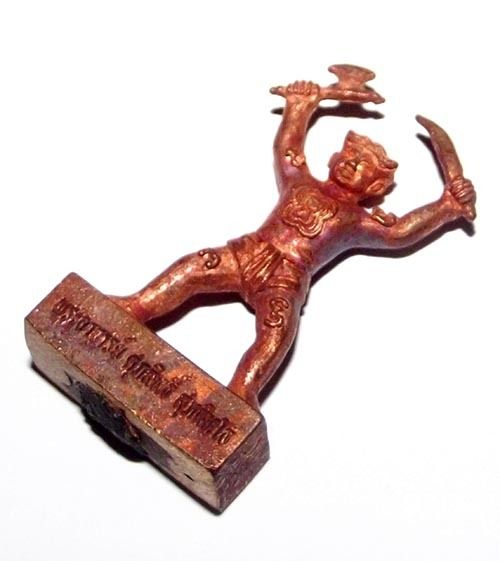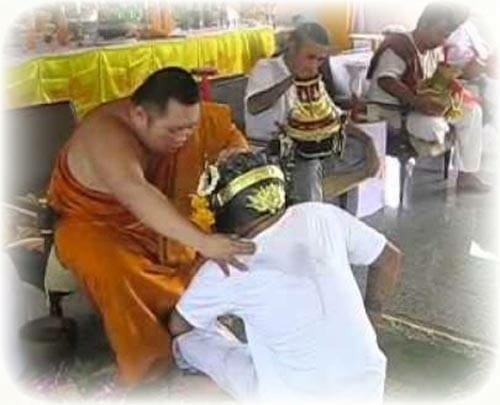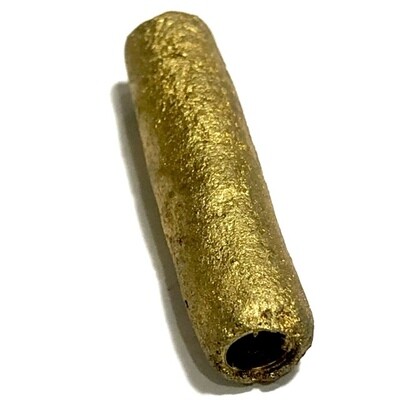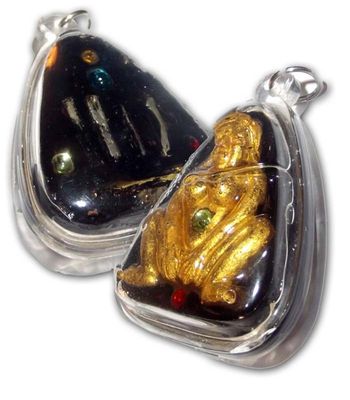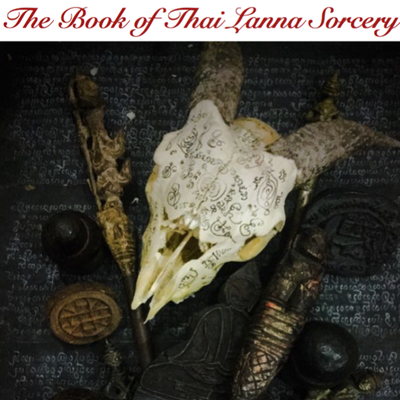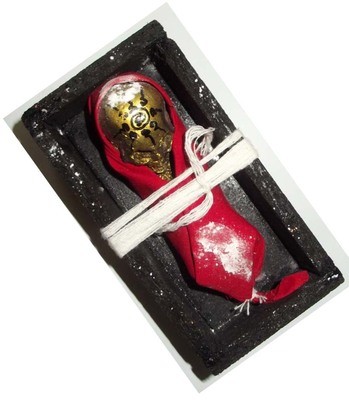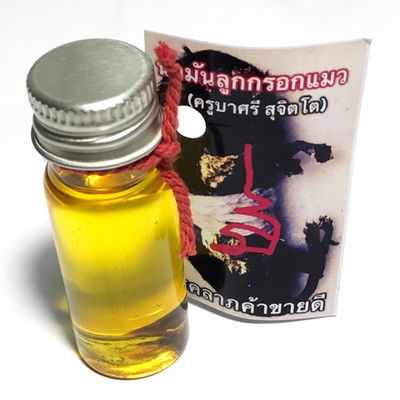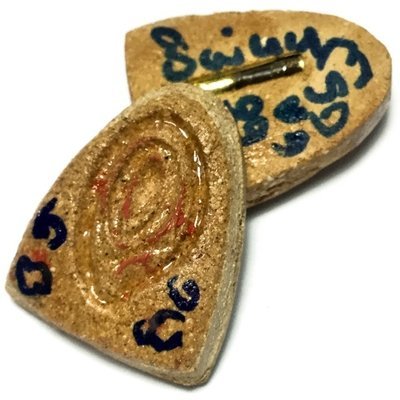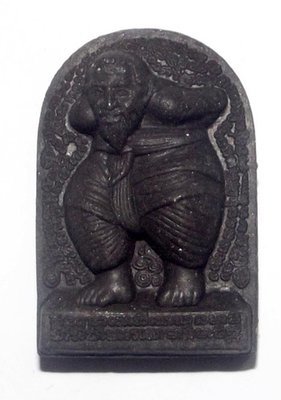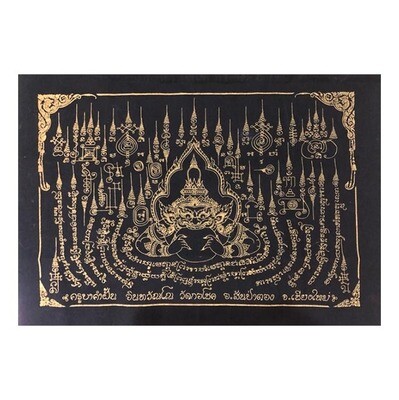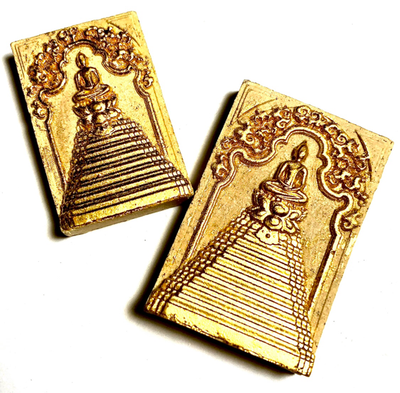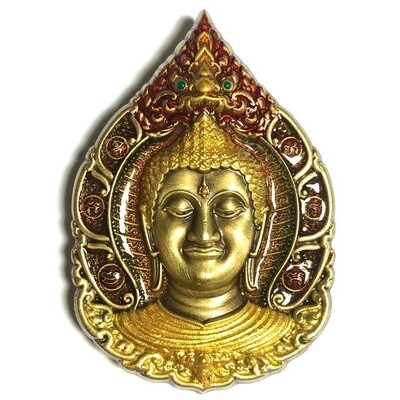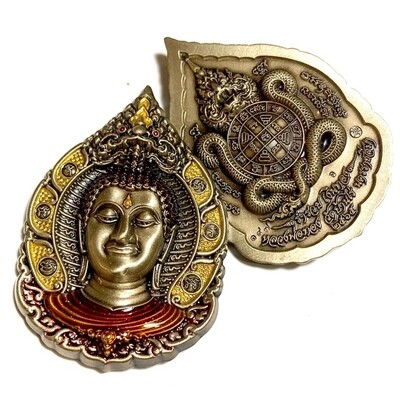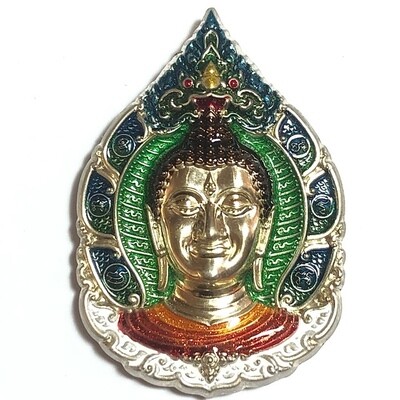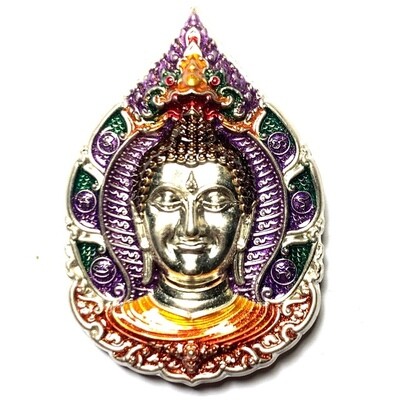

Thailand Amulets
Thai Buddhist and Magical amulets for Wealth, Health, Love and Happiness.
Vast Selection of Amulets
We have a vast selection of over 4000 different kinds of Sacred Amulets and Bucha Items, including Buddha Image, Loi Ongk statuettes, Buddhist Monk Coin Amulets, Takrut Charms, Nam Man Prai Oils, Mai Kroo Wands, Mitmor Ritual Knife, Lek Lai Kaya Siddhi Elemental Substance, Kumarn Tong, Gambling Amulets, Mae Nang Prai, Muan Sarn Sacred Powder Amulets, Palad Khik, Animist Charms, Necromantic Amulets, Buddhist, Animist, Brahman and Necromantic Amulets.
Por Payont Dam Ghost Soldier Spirit Protector Nuea Loha Aathan - Pra Ajarn Supasit Wat Bang Nam Chon
Por Payont Dam Ghost Soldier Spirit Assistant, in Nuea Loha Aathan Sorcerous Alchemical Metal alloy, from Pra Ajarn Supasit, of Wat Ban Nam Won.
The Por Payont Dam ghost soldier effigy is a remarkable artifact, created through a time-honored form of sorcery with roots in the ancient Siamese Kingdom and even predating it to the Khmer Empire's heyday. This animist practice has endured through the ages, surviving the transition from animism to Brahmanism and ultimately into the Buddhist era, where it became an integral part of the Siamese kingdom's cultural and religious fabric.

The ghost soldier effigy's immense popularity can be attributed to its powerful influence on the lives of those who use it for protection against dangers, thieves, and even black magic. The effigy is filled with Muan Sarn Sacred Powders, which include extracts of Paya Wan Dork Tong, Wan Sanaeh Jantr (both red and white varieties), and Wan Sau Hlong. These sacred powders were released during the Wai Kroo 255 BE Ceremony, further solidifying the effigy's significance in Siamese culture and history.

This edition boasts a range of models, each smelted according to the ancient alchemical metallurgy grimoires, and created in various sacred metals. Some of these models feature painted colored trousers, adding a vibrant touch to their design, and to cater for different tastes and preferences, as well as the magical effects which different colors emanate.
This model is made from Nuea Loha Aathan, meaning 'Sorcerous Iron'. The sorcerous iron is made from an alchemical mixture of Sacred metals which were made from smelted artefacts and yantra foils. Some of the ingredients of the Chanuan Muan Sarn ingredients include; Hlek Plik Sop (iron used to turn the corpse when cremating, Dtagraeng Phao Sop (grill for catching the remains of cremation), Dtapu Fa Loeng (nails from a coffin lid), Yant Solos Mongkol, Yant Naresuan Bpraab Hongs, Yant Paed Tidt, Yant Grao Paetch, Yant Hua Jai Hun Payont, Yant Maha Niyom, Yant Na 108.
The Ongk Kroo Masterpiece models are particularly noteworthy, with three distinct versions available. The first version is adorned with a silver Takrut, while the second version boasts a gold Takrut and is paired with green trousers. The top-tier model is truly exceptional, featuring not one, but two gold Takruts, complemented by red trousers and an infusion of Nam Man Prai Sacred Oil, enhancing its spiritual significance.
The enduring popularity of sorcery, particularly in the form of protective charms and talismans, remains as significant today as it was in antiquity. A prime example of this ancient practice is the amulet, a powerful symbol of defense against harmful magic and intruders.
In times of war, these amulets were a source of comfort and security for ancient warriors, who would wear them as they marched into battle. This tradition continued into modern conflicts, such as the Second World War, where Thai soldiers were often referred to as "ghost soldiers." This nickname arose from the fact that the vast majority of Thai soldiers employed some form of amulets or talismanic magic to safeguard themselves. Many of these soldiers were even adorned with Sak Yant Sacred Magical Tattoos, which are believed to confer spiritual protection and strength.

The Hun Payont, as mentioned in ancient texts, were powerful entities that played a significant role in many historical battles. These beings had the remarkable ability to create Nimitta Mirage images of themselves, which allowed them to multiply their appearance and project a hallucinatory image to the enemy. This visual deception made it seem as though a group of ten soldiers were actually a formidable force of one thousand.
The Hun Payont were infused with sacred Yant, which contained the potent Kata 'Hnun Taat See'. This Kata is the foundation of invoking a living entity into an effigy, and it is the first base of the invocation process. The Hun Payont's Yant and Kata were instrumental in their creation and deployment, making them formidable forces on the battlefield.

The Great Thai Sorcerer Monk, Pra Ajarn Supasit, has created a line of Hun Payont effigies, each meticulously crafted from various sacred alchemical metals. This particular model is made from Nuea Loha Aathan, a metal imbued with great spiritual significance. The term "Sorcerous Iron" accurately describes the unique composition of this metal, which is derived from an alchemical mixture of sacred metals.
These metals are themselves produced through a painstaking process that involves smelting various artifacts and yantra foils, each of which has been carefully selected for their spiritual properties. The resulting alloy is then used to create the Hun Payont effigies, imbuing them with a powerful aura.
The ingredients of the Chanuan Muan Sarn, the sacred mixture used in the creation of the Nuea Loha Aathan, include a range of items that have been carefully chosen for their spiritual significance. These include Hlek Plik Sop, iron used to turn the corpse during cremation, Dtagraeng Phao Sop, the grill used to catch the remains of the cremation, and Dtapu Fa Loeng, the nails from a coffin lid.
In addition, the Chanuan Muan Sarn includes a range of powerful yantras, each of which has been carefully selected for its spiritual properties. These include Yant Solos Mongkol, Yant Naresuan Bpraab Hongs, Yant Paed Tidt, Yant Grao Paetch, Yant Hua Jai Hun Payont, and Yant Maha Niyom. The inclusion of these yantras in the Chanuan Muan Sarn serves to further enhance the spiritual power of the Hun Payont effigies.
Overall, the creation of these Hun Payont effigies is a complex and painstaking process, one that requires a deep understanding of the spiritual properties of a wide range of materials and objects. Through this process, Pra Ajarn Supasit is able to create powerful spiritual tools that are highly valued by those who seek to deepen their spiritual practice.

The smelting of these metals and sacred yantra foils was a very difficult task to control the formula and bind the alchemical metals into one sacred alloy, and during the smelting of the metals into ingots, the assistants who were performing the smelting, could hear the sound of people walking up and down the building all night, as if a regiment of soldiers were patrolling the place. The effigy is filled with Muan Sarn Sacred Powders of Herbal and Necromantic nature, to increase the Maha Lap powers of the Por Payont, making him extremely useful in helping to increase wealth and lucky streaks, hence making this particular type of Hun Payont not only a protector, but also a good gambling and business mascot.
To introduce the Hun Payont into your home, light five incense sticks to honor the local resident spirits and ask for their permission to bring the effigy into your household. Offerings of spicy foods, fish or seafood, and liquor are customary to show respect and gratitude.
Kata Pluk Hun Payont
So Sa A Ni So Sa A Ni Sa A Ni So A So A So Ni Ni Sa A So Ni So A So A Ni Yo Sa A A Ni So Sa Sa Ma Su.
Kata bucha Hun Payont Boran
Na Mo Puttaaya – Na Mo Puttaaya – Na Mo Puttaaya
Imapata, Imapata, Imapata
Namo Poog Jidt Namo Poog Jai namo Rak Krai Na Pag Jai Sangko Tanya Udti Sangkhodti.
Kata Bucha Hun Payont (LP Naen Kampiro Lineage)
Om Na Ma Pa Ta Jaedta Phuudto Maha Phuudtang Hun Payondtang Nimidtang Gang Ruubpang Bpiyang Ma Ma Aehi Aehi Na Mo Put Taa Ya (chant 7 Times)
Kata Bucha Hun Payont Phu Maha Waet – Luang Por Goy – Wat Khao Din Dtai
This was a Hun Payont amulet empowered in solitary by Luang Por Goy, by calling the Prai Spirit to become a Hun Payont, and inhabit the effigy. The chanting of the Kata Hun Payont increases the awareness and magical power (Rit) of the Hun Payont.
Kata Bucha Hun Payont
Om Pluk Maha Pluk Goo Ja Pluk Phu Payont Duay Jae Dti Aa Gang Naa Ma Payont Ni So Sa A Naa Ma Dtae
The raising or keeping of a Hun Payont, and also actually the Mae Hong Prai Deity, is very much like that applied for the Kumarn Tong Deities, except that one shold consider the older age of these Deities when giving offerings. Each Individual Master may have different rules for the Hun Payont they make, which can be added or used to replace the usual Kata for chanting, depending on your preference and what feels faith instilling to you.
Before taking the Hun Payont into the house, you must light 5 or 16 Incense sticks and pray to the Jao Tee (local Devas and Spirit Guardians) and inform them that the Hun Payont is another welcome member of the Family.
Bucha Hun Payont
Light one stick of Incense (or Mae Hong Prai), and chant the following Kata
Jijeruni Jidtang Jaedtasigang iibpang Nimidtang – Por Payont – Aakajchaahi Aehi Aehi Na Ma Pa Ta Na La Poo Dtaa
(switch the word ‘Por Payont’ for ‘Mae Hong Prai’ if praying to Mae Hong Prai)
Kata for giving food and offerings
Yanginji Jidtang Itawaa Arungwaa Pochanangwaa Punchandti Aehi Na Ma Pa Ta Na La Poo Dtaa
You can be flexible with what you offer, depending on what is convenient or what you feel your Deities will like to receive.
Light incense sometimes – chant the Kata often.
Some people also offer Whiskey and Fresh boiled pork on Banana Leaf or Pandan leaf.
Kata for asking permission to use the Hun Payont to help complete a mission or other task.
Puttang Mahaa Araatanaanang Atitdthaami Puttang Mahaa Bprasittimae Tammang Mahaa Aaraatanang Atidthaami Tammang Mahaa Bprasittimae Sangkang Mahaa Aaraatanaanang Atidthaami Sangkang Mahaa Bprasittimae
Bucha Method for Hun Payont Maha Mongkol 9 by Luang Por Prasut (Wat Nai Tao)
This Hun Payont is Unisex (usable by woman or man), because it can be called upon to be a man or a woman. It is called Gao Mongkol, because Gao Mongkol means ‘Nine Blessings’ which are the nine properties of this amulet;
- Payont Kaa Khaay (assist in increasing sales)
- Payont Kong Grapan (protect from sharp instruments and bullets(
- Payont Maha Niyom (popularity, positive influence – great preference)
- Payont Maha Ud (gunstopper power)
- Payont Maha Sanaeh (charm, attraction, promotion, increase sales)
- Payont Fao Ruean Fao Rot (guard over the home or the car/vehicle)
- Payont Chai Ngaan (send on missions or to complete tasks)
- Payont Kumarn Tong (Kumarn Tong as Hun Payont)
- Payont Ko Taen Jao Khong Hnun Duang (take the brunt of your karma for you and increase your positive alignments)
Kata Pluk Hun Payont Pra Ajarn Prasut (Wat Nai Tao, Trang Province)
(Chant Na Mo Tassa Pakawadto Arahadto Sammaa Samputtassa x 3)
Bpatamang Pintugang Chaadtang Tudtiyang Pantaganjaewa Dtadtiyang Paetathang Jaewa Tadtuthang Angusampawang Bpanjamang Sirasangkhaadtang
(chant 3 ‘Karp’ (times), meaning one kata should be done in one in and out breath, three in an out breaths deep and slow to chant with – one breath counts as one ‘Karp’)
Then chant the following – Na Dti Dtan Na Ja one ‘Karp’
Por Tan Ajarn Prasut is a Master Guru Monk of the Khao Or Lineage of Southern Magical Wicha. He is allegedly able to invoke Hun payont to the point where they come to life and move around on their own and has mastered the agarn sam sip sorng wicha for bringing inanimate objects to life using the 32 conditions of the living body Incantation.
Kata Bucha ‘Hun Payont Boran Hying Chai Chay Hlong Chay Chai Hying Hlong’
Na Mo Puttaaya – Na Mo Puttaaya – Na Mo Puttaaya
Imapata, Imapata, Imapata
Saatu Saatu Saatu
Kata Pluk Hun Payont (animation spell)
Namo Poog Jidt Namo Poog Jai Namo Rak Krai Na Pag Jai Sangko Tanya Udti Sangkhodti
Kata Bucha Mae Hoeng Prai (Luang Ta Naen)
Offer whisky (one small glass), Light one stick of incense, and chant the following Kata;
Om U-U A-A Mahaa Phuudtaa Bpariphuudtae Phuudtiwae Sandti Na Ma Maa Maa
Chant repeatedly until entering a focused rhythm. Once you have achieved this, you can silently chant it throughout the day whenever you feel inclined to use the magic.
Kata Bucha Mae Nang Prai
I-Ta Tu-Sa Ma-So-o

Renowned for their exceptional craftsmanship, the amulets of Pra Ajarn Supasit, are highly valued for their superior quality and the intensely rigorous empowerments they receive. Pra Ajarn Supasit is recognized for his unwavering commitment to ancient empowerment techniques, a practice that is often complex and demanding.
The amulets he releases are few, and each edition is carefully curated to ensure only the highest quality and most powerful amulets are available. This exclusivity, coupled with the meticulous attention to detail in the empowerment process, makes Pra Ajarn Supasit's amulets highly sought after and highly esteemed.
Pra Ajarn Supasit's amulets are produced in such limited quantities due to the meticulous and intricate process involved in their creation. The primary reason for this scarcity is the high concentration of sacred Muan Sarn ingredients used in each piece. These ingredients, often sourced from sacred or hard-to-find locations, are carefully selected and integrated into the amulets. This meticulous selection process, coupled with the limited availability of these sacred materials, makes mass production of Pra Ajarn Supasit's amulets an impossibility.

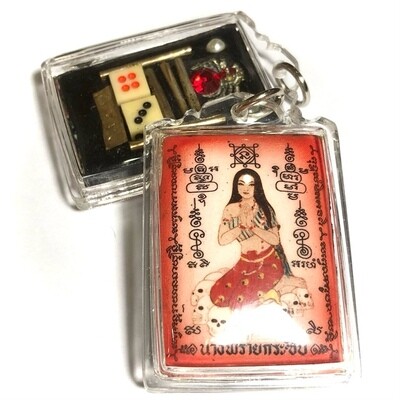
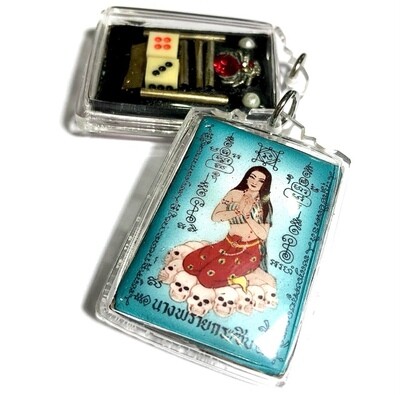
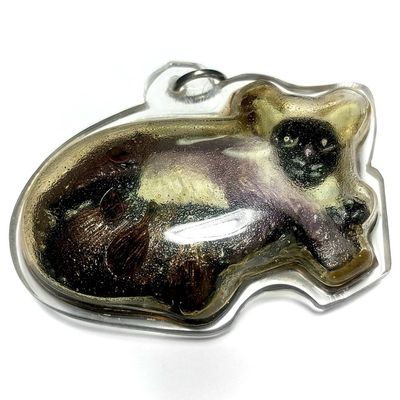


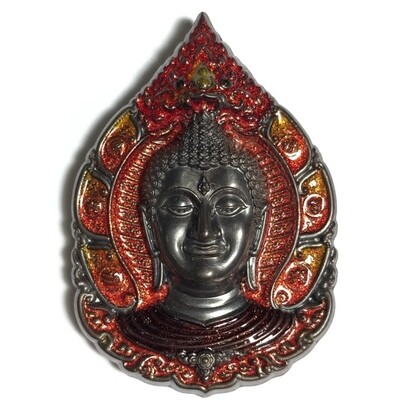

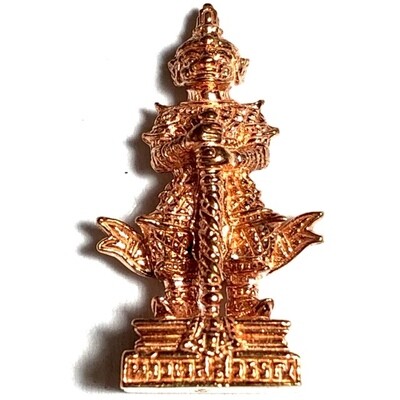
Contact Us
Follow Us on Youtube
About Us
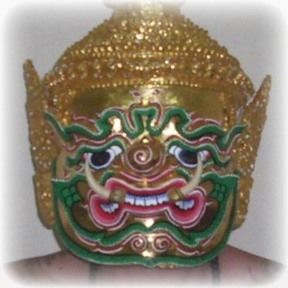
Ajarn Spencer
Proprietor
Thailand Amulets is owned and Administrated by Thai Occult and Amulet expert, Ajarn Spencer Littlewood who guarantees only authentic blessed amulets, and a free gift with every order, as well as his safe delivery or money back guarantee. https://facebook.com/ajarnspencer
